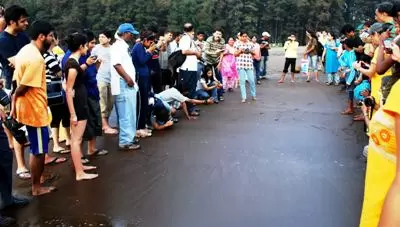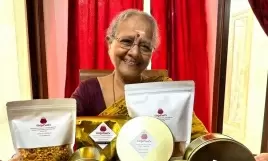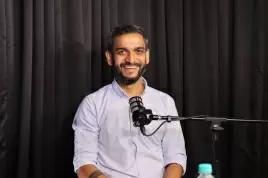An eco-tourist venture that prevented Olive Ridley turtles going extinct

11-March-2011
Vol 2 | Issue 10
Subodh Telang’s excitement over his first sighting of Olive Ridley turtle hatchlings is rather infectious. “The hatchlings were hardly 5 to 7 grams as
I took them in my palm as soon as they emerged from underneath the sand,” he says.
“The experience was awesome,” Subodh adds, not for a moment cribbing about the six hour bumpy ride from Mumbai to Velas in Ratnagiri district and then waking up at 5.30 am to spot the hatchlings on the Konkan coast.
The excitement is shared by more than 500 tourists who have already flocked to see the turtles at the ongoing ‘Turtle Festival’ at Velas. The festival started on February 21 and is likely to go up to March end or April first week depending on the hatching of eggs in 22 nests.
 |
|
Tiny charmers: The baby Olive Ridley turtles are crawling into the sea, watched by fans who have poured in from places miles away
|
“Hatching has already taken place in 12 nests and when all the nests hatch, 800 hatchlings are expected,” says Bhau Katdare, honorary secretary of the
NGO ‘Sahyadri Nisarga Mitra’ (Friends of Western Ghats Environment) of Chiplun. They have jointly organised the festival in association with ‘Kashav Mitra Mandal’ (The Turtle Friends Association) Velas, and the Forest Department. Ten percent of income earned through this tourism goes towards conservation of the turtles.
Most tourists are enthralled by the experience. “I came to know about this festival from a newspaper and thought of spending a day here. However the ambience, hospitality of the villagers and the sheer thrill of experiencing the emergence of hatchlings from the nest made me stay for three days and I am coming again,” says one of them. The festival organisers arrange for cheap accommodation and food - at the rate of Rs 280 per person per day.
The best time to watch the hatchlings is at 7 am and 6.30 pm when volunteers would release them into the sea. “In evenings we show films about turtles that emerge from the sea and come to the beach to lay eggs under one to two feet of sand. Each turtle lays eggs from November to February and sometime as late as early April,” says Mohan Duttatreya Upadhye of Kashav Mitra Mandal. The eggs take 45-50 days to hatch, depending on the temperature of the nest.
Of the seven species of marine turtles, five are seen in the Maharashtra coastline and all of them are endangered. But it is the Olive Ridley that comes out to lay eggs in the beach. Each lay about 100-115 eggs and goes back into the sea.
Bhau Katdare, (49), who started Sahyadri Nisarga Mitra (SNM) as a youth in 1992, recalls villagers selling the eggs for Rs1to Rs5 each. Since the poaching took place at night, SNM took to patrolling at night. It took time to convince the villagers that selling the eggs was illegal as marine turtles were endangered species.
“Now no one eats turtle eggs; everyone has understood the importance of conservation that has also given them livelihood as tourists flock to the villages to see the turtles,” says Upadhye. In the last eight years SNM has undertaken turtle conservation in 35 villages along the Maharashtra coast. They have released over 28000 hatchlings into the sea.
















